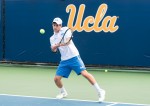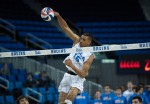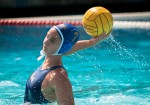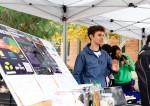The Bruins will have a chance to defend their three-year home win streak with a home doubleheader to open their regular season.
No. 7 UCLA men’s tennis will face off against Nevada and UC Davis. Originally scheduled for Wednesday, the matches have been postponed due to forecasted rain. They will take place at a later, unspecified date at the Los Angeles Tennis Center.
Coach Billy Martin said doubleheaders are a good evaluating tool because of how many different players get to see the court.
“I don’t want … any guys playing two singles and two doubles matches on the same day,” Martin said. “It gives me an opportunity to play a lot more guys and get a feel for them and make sure everyone contributes.”
UCLA is fresh off a fall season that was filled with numerous preseason tournaments, many of which gave younger players the opportunity to adjust to collegiate tennis.
In 2018, the Bruins swept the Aggies 4-0 at the ITA Kick-off Weekend, helping them qualify for the ITA national indoor championships. The Aggies posted a 9-18 record overall last season.
UCLA has also faced many of the UC Davis players in action from various preseason tournaments in the fall.
At the Jack Kramer Invitational in November, sophomore Connor Hance defeated UC Davis’ Daniel Landa 6-1, 6-1. Both sophomore Keegan Smith and freshman Eric Hahn encountered UC Davis players at the same tournament and emerged victorious from their respective matches.
Junior Ben Goldberg said the team will need to remain focused if it is to win.
“You have to treat everybody the same,” Goldberg said. “You can’t take anything for granted. We are UCLA and everybody comes in ready and wanting to beat us. We have to stay ready for anybody at all times.”
UCLA will also face Nevada the same day. Unlike UC Davis, the Nevada team will consist of a number of new faces for the Bruins, as they will be facing the Wolf Pack for the first time since the start of Nevada’s program in the 1971-1972 season.
Nevada finished last season with a record of 15-8 but has not posted a winning record in its conference for the past three years.
However, Martin said underestimating any opponent is dangerous.
“If anybody is taking practice too casually, they just won’t play,” Martin said. “We can’t afford to be sloppy. We haven’t proven that we’re a great team yet, and we need to play scrappy and hard every match.”
As the reigning Pac-12 champions, the Bruins need to make defending their home court a priority if they are to be successful this season, Martin added.
“In my time here, we have never lost a match at home,” said redshirt sophomore Connor Rapp. “Most guys on this team are pretty close to home, so the fans that come out and support us are pretty special.”
Goldberg said the squad this year, ranked No. 7 in the nation according to the ITA preseason rankings, is full of exciting younger players that are looking forward to regular season play.
“It may take a little while for everyone to get used to one another,” Goldberg said. “In the end, I think we could be really good, and we’re looking forward to it.”






